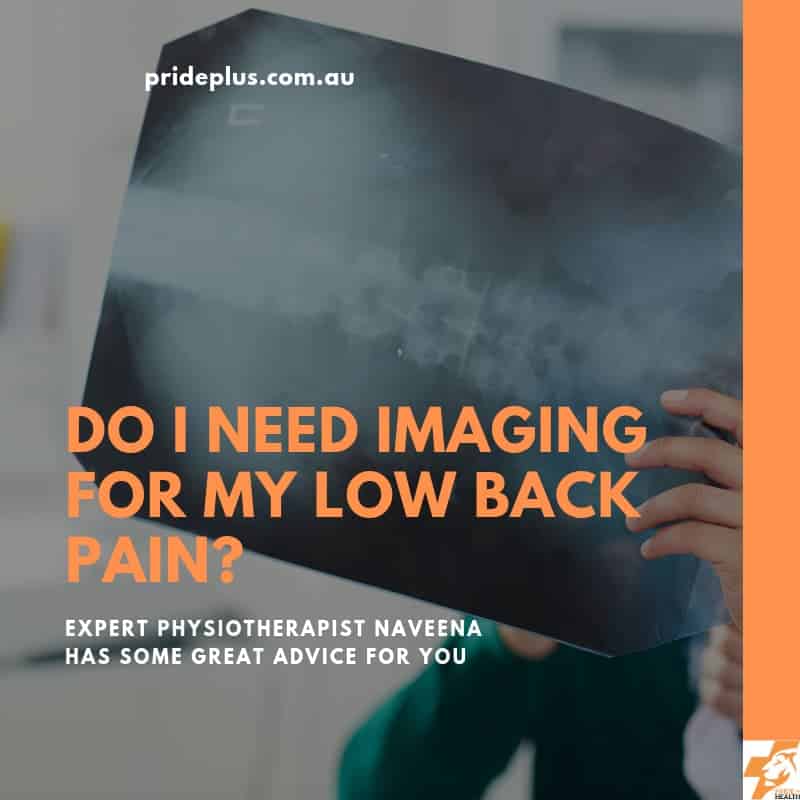As an experienced physiotherapist the one question that I get asked most frequently by clients with low back pain is:
“Do I need Imaging for my low back pain?”
As any good health professional knows when asked a question we almost always counter with another. With this in mind I like to ask them back:
“Do you think you need imaging? Really? Why is that?”
It is interesting to hear their reasons and most of them center around the following:
“I need to know where the pain is coming from – it was not there last week, it is here now, surely something must be damaged”
“I am worried my disc is out”.
There is this overwhelming need to know what exactly has been damaged.
“How bad is the damage?”
Then there is a need to have a mental picture of the structure.
“What does it do, what should it look like? What does mine look like?.”
Often the need to ask Dr Google specific questions.
“Should I ride to work if I have a low back injury?” “Will turmeric fix my low back pain”
Then the need to have a specific diagnosis, rather than the generic low back pain.
Hand on heart, doesn’t it sound better to say “I have a disc prolapse” rather than “I have low back pain”?
There is the validation of seeing or hearing that something is damaged – leading to pain. Otherwise, our doubts circle around
“Is this pain all in my head?”
“Could this be something sinister?”
“Is this the beginning of my end?”
In an ideal world, these scans should tell us what exactly is wrong and how exactly to fix it.
Unfortunately, this is not the case and I would like to tell you why
- Many of the findings that show up in the scans of people with low back pain are also found in people with no low back pain as well. This is especially true in people over the age of 50.
- Then there are plenty of age-related changes found in most scans and it is nearly impossible to pin it down to one particular structure that is causing the current pain. This is like the needle-in-a-haystack (or should that be the needle-in-a-sore-back?) scenario.
- We now know that the cause of low back pain is multifactorial. This includes a combination of biophysical (structures in the low back), psychological (how we interpret and process negative stressors) and social factors. Scans look at only one aspect of low back pain, the biophysical.
- The scan findings will not inform us of the course your low back pain is going to take. They cannot predict how long it is going to take to recover or whether you will have it again in the future.
- Scans are also more technical than the few lines in the “conclusion/results” part of the imaging report. For example, how a structure is viewed depends on the resolution used in the scan. There is a potential for two different radiologists to view a structure in more than one way. Have you noted the disclaimer “the scan findings should be correlated with clinical findings” at the end of each report? This adds ample proof to the argument that they are never stand-alone findings.
- Ever wondered what happens to the positive findings in the scans after your symptoms have vanished? You would be surprised to find that many a time they would still be there. So what exactly was ‘damaged’ and what has ‘healed’?
To conclude, evidence has shown that using scans taken routinely in low back pain does not improve patient outcomes nor does it add any value to the treatment. Therefore it makes more sense to treat you, our valued patient, rather than treat the scan.
Now, after reading all this there are situations where scans are absolutely crucial! Not so much in low back pain. It’s best to leave it to the expert health professionals, like physiotherapists to work out when they are absolutely needed.
If you would like to learn more about low back pain treatment you can read Dominic’s excellent post.
References
What low back pain is and why we need to pay attention
The Lancet (2018)
Jan Hartvigsen, Mark J Hancock, Alice Kongsted, Quinette Louw, Manuela L Ferreira, Stéphane Genevay, Damian Hoy, Jaro Karppinen, Glenn Pransky, Joachim Sieper, Rob J Smeets, Martin Underwood, on behalf of the Lancet Low Back Pain Series Working Group
People with low back pain want clear, consistent and personalised information on prognosis, treatment options and self-management strategies: a systematic review.
Journal of Physiotherapy (2019)
Yuan Z Lim, Louisa Chou, Rebecca TM Au, KL Maheeka D Seneviwickrama, Flavia M Cicuttini, Andrew M Briggs, Kaye Sullivan, Donna M Urquhart, Anita E Wluka




